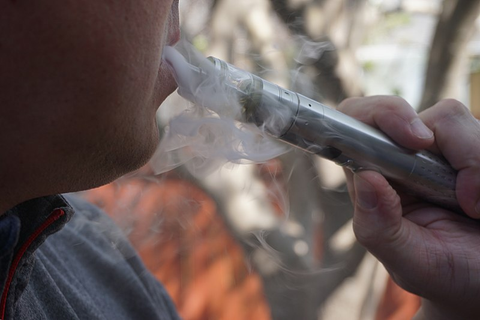Here’s 3 Common Reasons You Get a Sore Throat from Vaping (and How to Get Rid of It)
Note: If you are experiecing a sore throat that feels like it could be a flu or virus, don't mess around. Read the CDC guideines on Coronavirus symptoms.
As vapes continue to grow in popularity, an increasing number of rookie vapers report that they’re getting bouts of sore throat from vaping. From consumer surveys to product reviews and social media, a noticeable number of vaping greenhorns are bringing attention to unpleasant conditions they attribute to vapes.
The most common of these are sore throat from vaping and the notorious “vaping illness,” known formally as e-cigaretteF%7B0XCAB)LKNIT0K@G.gif) aping product use-associated lung injury, or EVALI. Others even claim to be experiencing the aptly-named cobblestone throat, which is essentially an irritation resulting in excess mucus production, making it painful to clear the throat.
aping product use-associated lung injury, or EVALI. Others even claim to be experiencing the aptly-named cobblestone throat, which is essentially an irritation resulting in excess mucus production, making it painful to clear the throat.
F%7B0XCAB)LKNIT0K@G.gif) aping product use-associated lung injury, or EVALI. Others even claim to be experiencing the aptly-named cobblestone throat, which is essentially an irritation resulting in excess mucus production, making it painful to clear the throat.
aping product use-associated lung injury, or EVALI. Others even claim to be experiencing the aptly-named cobblestone throat, which is essentially an irritation resulting in excess mucus production, making it painful to clear the throat.If you’re a vaper experiencing any of the conditions mentioned above, you’re in luck. In this post, we discuss the causes of the most common vaping side effects — from burning throat to lung pain — in ample detail, and go into how you can avoid them with ease.
Going Overboard on Nicotine Content
Nicotine levels are by far the leading cause of sore throat from vaping as well as general throat irritation, and with good reason.
Nicotine levels are by far the leading cause of sore throat from vaping as well as general throat irritation, and with good reason.
According to the National Center for Health Statistics, a large percentage of vapers are ex-smokers. More often than not, new vapers making the transition from cigarettes expect a flat and unsatisfying experience from their first vape, and go for the highest-nicotine e-liquid they can find to guarantee their cravings are sated. The truth is only pack-a-day smokers require high nicotine level e-liquids, which are typically at 2.4 percent per the industry standardized increments. Casual smokers, as well as smokers who prefer lights or menthols, can stand to vape lower nicotine strength e-liquids.
Going overboard on nicotine can overwhelm the system, causing conditions such as burning in throat, pain when inhaling and vaping lung disease symptoms.
Vaping Like a Nicotine or Flavor Fiend

For the same reason as described above, new vapers transitioning from cigarettes also have a tendency to vape too eagerly, for lack of a better term. While they might purchase vape juice containing the correct amount of nicotine for them personally, sensations of withdrawal (or the anticipation of a good hit) cause some newbie vapers to draw on vapes with the same intensity as they draw on their favorite cigarettes. This almost inevitably causes anything from a sore throat to full-blown pharyngitis.
The reason for this is simple: conventional cigarettes are typically laced with mild anesthetics that allow users to smoke more cigarettes, and for longer periods of time. These anesthetics basically dull the pain of inhaling dangerous irritants and are part of the habit-forming nature of tobacco cigarette design. Conversely, e-liquids contain no anesthetics, which make them better for users in the long run with the tradeoff of increased throat sensitivity.
Smoker’s Flu from Lack of Nicotine
Smoker’s flu is a generalized term used to describe a variety of conditions that come with severe nicotine withdrawal. These including abdominal pain or nausea, cold or cough, migraines, insomnia and — you guessed it — feelings of pain, dryness or irritation in the throat. Smoker’s flu commonly afflicts ex-smokers who’ve transitioned to nicotine-free vaping in order to kick the habit altogether, and typically subsides within weeks of consistent abstinence.
Smoker’s flu is a generalized term used to describe a variety of conditions that come with severe nicotine withdrawal. These including abdominal pain or nausea, cold or cough, migraines, insomnia and — you guessed it — feelings of pain, dryness or irritation in the throat. Smoker’s flu commonly afflicts ex-smokers who’ve transitioned to nicotine-free vaping in order to kick the habit altogether, and typically subsides within weeks of consistent abstinence.
How to Get Rid of Sore Throat from Vaping & Keep It Away for Good

There are several ways to prevent throat and lung-related malaise when vaping. However, aside from sticking with appropriate nicotine levels and taking slow, deliberate draws, the single most effective method to avoiding sore throat is to stay well hydrated.
What’s hydration got to do with it? Simple: e-liquids consists of nothing more than nicotine, flavoring and a base. The base is comprised of either propylene glycol (PG), vegetable glycerin (VG) or a ratioed combination of both. Both PG and VG are used specifically because they attract moisture, as this causes them to effectively lower the boiling point of liquid nicotine, eliminating the need for combustion. Because of this moisture attraction effect, prolonged vaping of e-liquid can cause the mouth and throat to dry out — rendering it much more sensitive to irritation as users continue to vape.
With proper selection of e-liquids, well-moderated vape usage and proper hydration, vapers of all levels can enjoy their devices, flavors and nicotine without worry of getting a sore throat from vaping.
